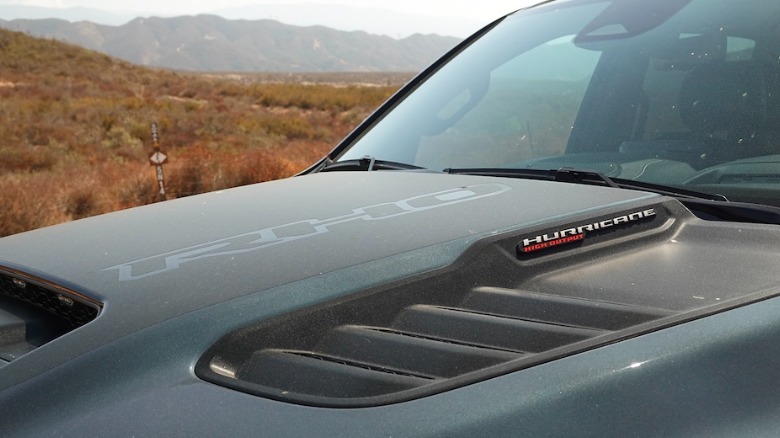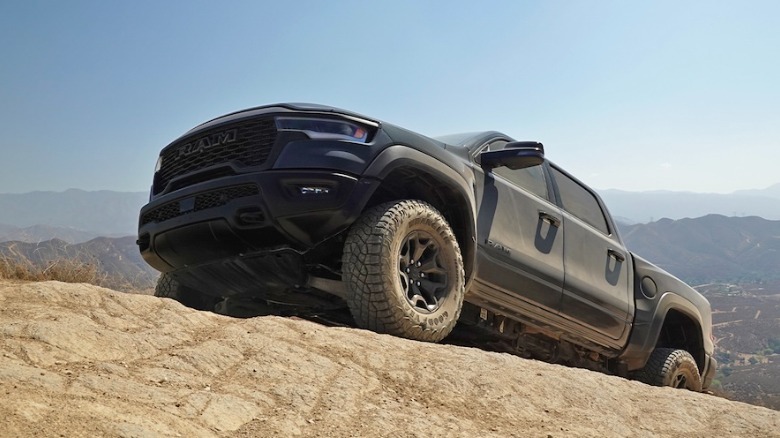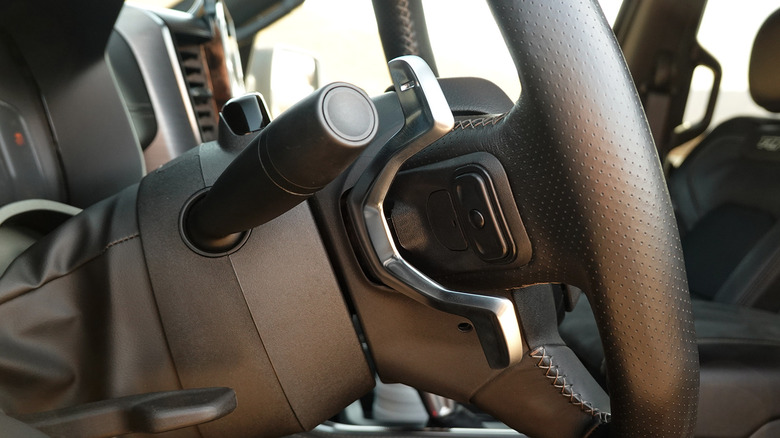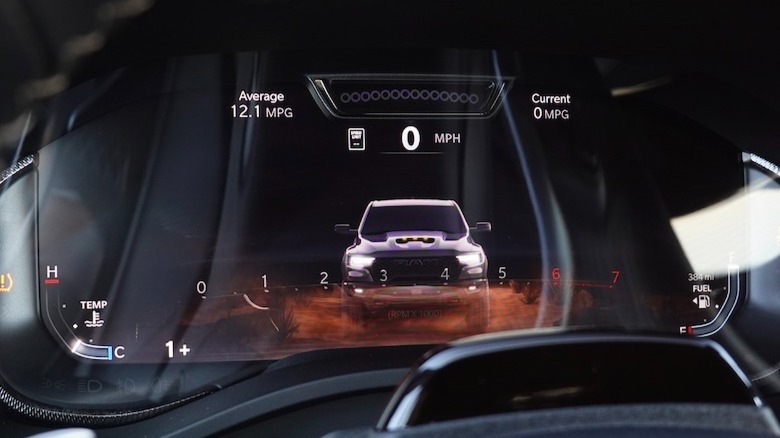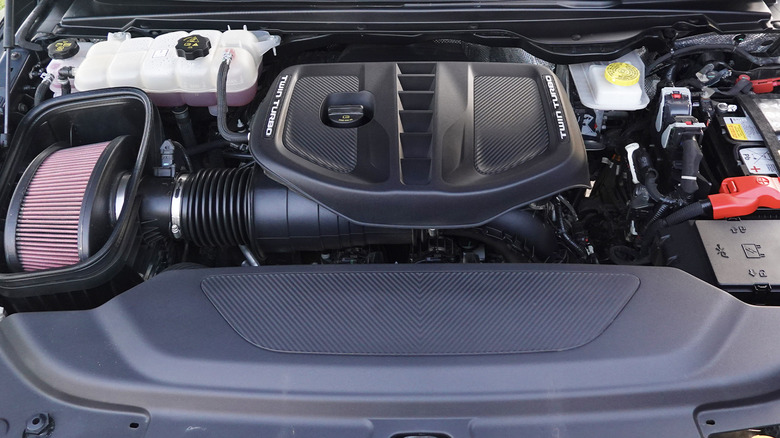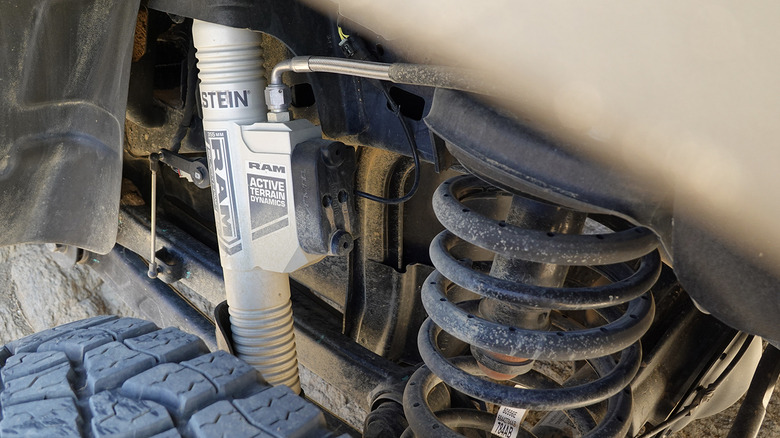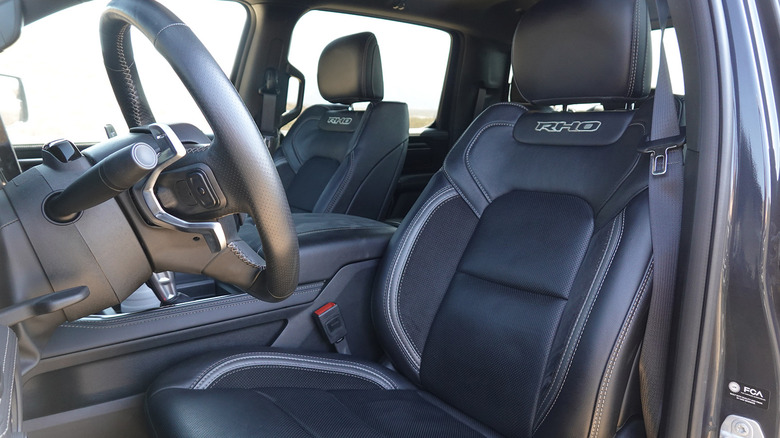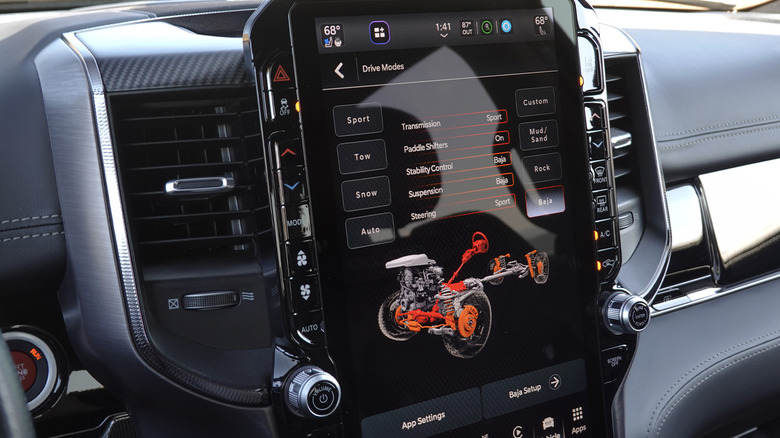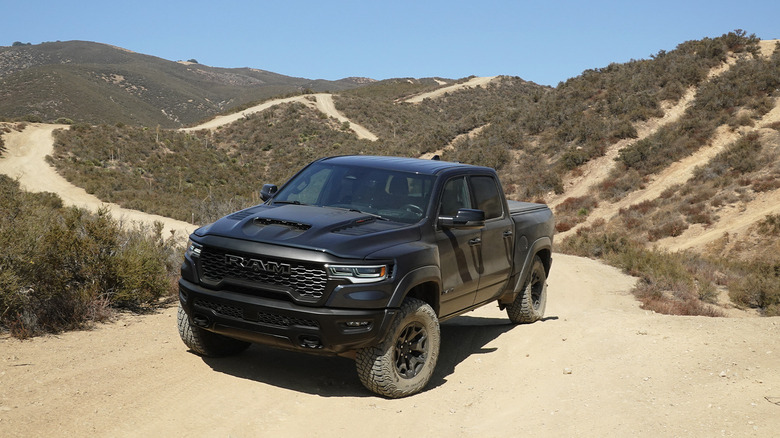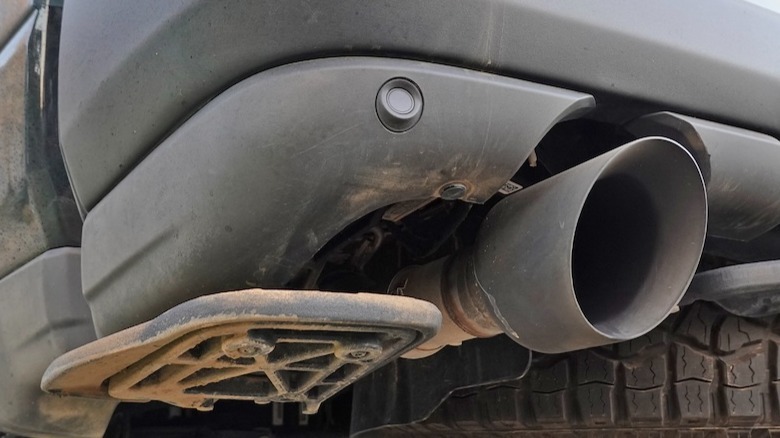The 2025 Ram 1500 RHO Gets Everything Right At The Worst Possible Time
For model year 2026, Ram decided to revive the V8 engine—albeit in hybrid form—for the entire 1500 pickup truck model line. The about face should come as no surprise given the pressing combination of customer demand, industry regulation reversals, and the hiring of former Dodge CEO Tim Kuniskis. But that left Ram's high-spec 1500 at something of a disadvantage, since the RHO "Ram High Output" replaced the TRX's supercharged Hellcat Hemi back in 2024 with "just" a twin-turbocharged 3.0-liter inline-six.
To help bridge the gap, Ram added a new MagnaFlow exhaust system as an option to the RHO this year, hoping the burbling pipes might uncork a bit more beef from the Hurricane six. The RHO still delivers the rest of the absurdity that made the TRX so intimidating—other than a much more approachable price tag. I took an RHO as a loaner in Los Angeles, maybe one of the worst places to experience the enormous truck's cartoonish dimensions in daily life, but also close enough to nearby deserts to enjoy that newly acoustic engine during some high-speed ripping.
Priced for the real world
Ram's trucks truly border on luxury vehicles these days, with eminently comfortable seats and premium materials in all but the base trims as befitting an $84,420 beast. That MSRP builds a fair amount on the base price of $69,995 (internet numerologists, please hold your fire) by adding even more luxurious trappings, including massaging front seats and ventilated rears.
The RHO in particular includes some plaques and badges, of course, but the rest of the dash and center console looks largely familiar, from the 14.5-inch UConnect touchscreen to the switchgear and the 12.3-inch digital gauge cluster. At least the RHO retains a physical gearshifter, versus a selector knob on other trims, but I don't particularly need such a digitalized truck. Maybe the carryover from a TRX that easily eclipsed six figures when new explains the tech.
All the drive modes for any terrain
Unique RHO drive mode buttons to the right of the steering wheel flip through various settings, including a little launch control option. And the digital cluster can show unique renderings of the RHO traversing dirt trails and Baja conditions. I wanted to play with the four-wheel-drive selections while blasting around, so I headed out to my typical test trail at Rowher Flats. Airing down to only 24 PSI seemed appropriate, given the RHO's size and weight as well as how much I wanted to avoid de-beading a tire while out in the desert solo—always a no no, but c'est la journalist vie.
I consciously avoided sharp rocks, which this truck certainly did not appreciate with every last of the 540 horsepower and 521 lb-ft raring for a chance to unleash four-wheel drifts with ease. But first, I climbed up the usual hill climb, sticking in full-time four-wheel drive and never even needing to drop down into four-low. The rear locker helped a few times with some cross-axle articulation, where a disconnecting sway bar might make a difference on a rig that prioritizes rock crawling. Even 14 inches of rear wheel travel can only do so much.
But mostly, at such slow speeds, I worried about engine bay temps due to the dual snails and the torque converter struggling with so much grunt, but all looked fine on a hot day. And I simply cannot recall ever off-roading with both ventilated and massaging seats running before, either...
Paddle shifters that aren't paddles
Locking in first gear via manual mode helped to render four-low unnecessary, as did the small-ish 35-inch tires (325/65R18 to be specific, of 34.6 inches in diameter when fully inflated). But actually blipping through gears brought up one of the RHO's most frustrating flaws, quite possibly the worst paddle shifter design ever.
The goal appears to have been retaining Ram's typical audio buttons on the rear of the steering wheel, so the shifters appear as one piece from the driver's perspective but actually split in the middle. They look less like paddles, in fact, and more like thickly half circlips or something. With hands at 3 and 9 o'clock, I continually missed the shifter with my index and middle fingers right at the shifter's gap.
This becomes more crucial in the higher-speed terrain, because the Hurricane engine loves to rev up into the turbocharged power band. Doing so in Baja, rather than the inline-six or turbos demanding attention, my focus turned directly to the spectacular Bilstein suspension. We might lack the TRX's 702 horsepower and 650 lb-ft of torque, but at least the RHO weighs a couple of hundred pounds less on the nose.
This truck drives like a side-by-side
Even a little less front bias helps the RHO transform into essentially a gigantic side-by-side. My courage built up minute by minute, at first trying to take ruts and whoops slow and steady, worried about the Goodyear Wrangler Territory AT tires slicing a sidewall as I slid around sideways. I also tried not to bottom out too much.
But the drifting and jumping just became too much fun. The Hurricane engine can easily break any tire traction loose at full throttle, but also hammering the brakes wagged the tail frequently as well. Any pickup truck typically lacks weight over the rear tires, relatively speaking, even despite the overall mass and the increasing prevalence of extended cabs and short beds.
The best suspension, bar none
By the time I started my return to asphalt, I spent the rest of the drive fully jumping the RHO, the Bilsteins sensing lift and preventing any bottoming out along with the hydraulic jounce control. But I also never noticed the awkward clunking of full droop—a masterful engineering feat, given the size and weight of this truck and its suspension componentry.
Because of those impeccable Bilsteins, I struggled to compare the RHO to Ford's many Raptors. The Bronco Raptor's shorter wheelbase only ramps up the side-by-side comparisons, and the Fox Live Valve dampers offer selectable firmness. But I still think the Bilstein dampers take the cake. Of course, then the F-150 Raptor R still comes with a supercharged V8 this very year, plus the 37-inch tires that make even more of a difference. And the Ranger Raptor, though much smaller than the rest and much more liveable, lacks the hard-charging character of the rest of the lineup.
Life with the RHO
Speaking of livability, I adjusted to daily driving the RHO almost unbelievably quickly. At first I worried about the width more than anything, and the fender flares do somewhat disappear behind the massive hood from the driver's perspective. But the steering response allowed for a surprising amount of feedback into my hand, so I knew where each tire rode despite the lack of visibility.
Other annoyances appeared, though. Off-road, the trail camera views kept disappearing after 15 seconds, rather than staying on consistently after I activated the cameras to help with visibility over the ginormous hood. So pretty much as soon as I got the cameras sorted, and pulled forward to approach an obstacle, they then turned off. Not ideal in any hardcore rock crawling situations—which I am fully aware the RHO should not do, anyhow.
Stop that incessant racket!
Plus, in every scenario, specifically, we need to talk about the honking. The darn tootin' if you will. This problem haunts the entire Stellantis lineup, and admittedly Ferrari's frequent beeps and honks totally take away most from any semblance of seeming suave or sophisticated while pulling up to a fancy soiree. Chalk that quirk up to Ferrari-ness, if you must...
But dealing with the Ram RHO almost ends up worse, precisely because this truck does other truck stuff so well. Want to hop out and keep that engine running while off-roading, either to scope out a tough obstacle or check tire placement? Never turn a truck off in the middle of nowhere, a lesson I learned early in my off-roading career when my Montero's ignition switch gave up the ghost deep in Joshua Tree National Park, applies not here. Regardless of whether I left the RHO's key in the center console or in my pocket, the truck doth protest.
Trust the truck, and the driver
With the key in my pocket, the RHO honked consistently as soon as I shut the driver door. If I left the key inside the vehicle, the truck still honked but also flashed the hazard lights on and off at random intervals. This makes zero sense, especially when I needed to air the tires back up with my Viair compressor, which requires leaving the engine on to prevent the battery from dying. So with my head under the hood hooking up the battery terminal leads, I got the dubious pleasure of getting my eardrums absolutely blown out by the incessant honking.
Now imagine I drove the RHO to a sketchy neighborhood, not just for off-roading. Okay, I left the engine running to keep the air conditioning on, with my dog in the truck. I run inside to do something, but the truck won't stop honking and the lights won't stop flashing. This only brings on more unwanted attention. How about trusting my ability to lock and unlock a truck, to leave the engine running when I want to or not—especially if it's got a MagnaFlow system burbling as a clue—rather than alerting everyone in the entire vicinity that hey, this expensive and powerful pickup truck is unlocked and also running! And don't even ask about my poor neighbors dealing with the honking at 5am.
Self driving works fine for fighting traffic
After all, trucks so often serve as little more than a means to an end. Of course, trucks in the same vein as the RHO also transform into toys—and I cannot understate the fun factor of whipping around sideways in something so enormous. But if I lived with the RHO longer, that Hurricane engine might split duties as a daily driver, an off-road trail hunter, but also a motorcycle and trailer hauler. I doubt the Hurricane six posts big fuel economy gains versus the TRX when trailering, after experiencing the power curve both on and off-road. The EPA estimates real life gains of about 3 MPG versus the Hellcat, and my truck averaged just over 12 MPG combined for a week where I doubt the TRX can break into double digits very often.
That includes a range of driving conditions, a byproduct of laughable aerodynamics, the huge tires, and the power output. At least eight-speed automatic's gear ratios help, and I do wonder whether my few attempts at using Hands-Free Active Driver Assist (Ram's no-frills name for the function, versus Super Cruise and BlueCruise for GM and Ford, respectively) actually helped the fuel economy or hindered. Regardless, even while stuck in traffic on the abysmal asphalt of the 405 freeway while headed home, after spending too much time getting filthy in childlike glee, the self-driving turning on and off seemingly randomly, I still spent most of the time simply marveling at the RHO's suspension.
Just wait for the TRX's return
This simultaneously hardcore and ridiculously luxurious truck can even drive relatively silently, until the urge strikes once again to mash the throttle and spool up a bit of turbo whine. Most little flaws can't detract from that fact—other than how much I just missed the supercharged Hellcat Hemi. Sure, that V8 might hoover up more fuel, but the supercharger screaming to high heaven, all the power and the glory forever and ever, sure makes up for the slight increase in use cost.
Hence why Ram under the rule of Kuniskis already announced plans to bring the original TRX DNA back to life, Jurassic Park style, for model year 2026. Full details remain under wraps, including whether the Hellcat can pump out more horsepower and whether Ram can charge even more than for the previous generation. And why not, after all? Can't let Ford keep the upper hand. Which unfortunately leaves even the MagnaFlow-equipped RHO, unless specced as cheap as possible with absolutely zero options to max out smiles per dollar, as something of a lame duck for the rest of this year.



